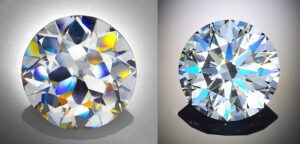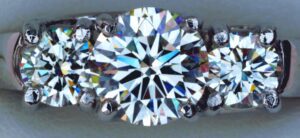Round Brilliant Cut Beauty and Light Performance Part 2
Going back over 100 years, numerous efforts have been made to analytically prove the superiority of the small range of angles called ‘Ideal’. Several metrics and methods have been developed in attempts to provide this proof. Ray tracing was employed by many (e.g. Marcel Tolkowsky in ‘Diamond Design’). Others developed measures of aspects of diamond beauty, such as brilliance and fire, including, in the United States, the grading laboratories of the GIA, and the AGS.
It is problematic that metrics most often fail to point to why this small range of key angle combinations is best. Instead, most metrics of brilliance and fire show peaks or maxima well away from the narrow range graded ‘Ideal’ and ‘Excellent’.
Presented in this article are answers to why the ‘Ideal’ Cut’s small range of angles is best. Analytical lighting and photography, and reverse ray tracing through the brilliant cut’s crown facets are used to analyze and gain an understanding of its light performance. An important element of this analysis, introduced in this article, is the concept of the ‘diamond’s eye’. Together, these analysis techniques are employed to explore the range of angles found to be the best or ideal by GIA Laboratories (the Excellent grade); by AGS Laboratories (the AGS 0 Ideal); and by diamond cutting schools and institutions and the author. Negative light performance effects ensue when a diamond is cut outside of this range of best angles. These are explored and analyzed.

See the article and download a copy at: Round Brilliant Cut Beauty and Light Performance Part 2
